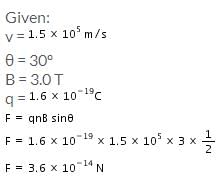All Exams >
NEET >
NCERT Based Tests for NEET >
All Questions
All questions of Moving Charges and Magnetism for NEET Exam
If we double the radius of a current carrying coil keeping the current unchanged. what happens to the magnetic field at its Centre?- a)halved
- b)doubled
- c)remains unchanged
- d)becomes four times
Correct answer is option 'A'. Can you explain this answer?
If we double the radius of a current carrying coil keeping the current unchanged. what happens to the magnetic field at its Centre?
a)
halved
b)
doubled
c)
remains unchanged
d)
becomes four times

|
Ciel Knowledge answered |
As,
B=μonI/2a
a ->radius
B ∝1/a
B1/B2=a2/a1
B1=2B2
B2=(1/2) x B1,
Magnetic field is halved.
B=μonI/2a
a ->radius
B ∝1/a
B1/B2=a2/a1
B1=2B2
B2=(1/2) x B1,
Magnetic field is halved.
Two thin long parallel wires separated by a distance b are carrying a current i ampere each. The magnitude of the force per unit length exerted by one wire on the other is- a)

- b)

- c)

- d)

Correct answer is option 'D'. Can you explain this answer?
Two thin long parallel wires separated by a distance b are carrying a current i ampere each. The magnitude of the force per unit length exerted by one wire on the other is
a)
b)
c)
d)

|
EduRev Humanities answered |
Given, i1=i2=i
∴F=μ0i2l/2πb
Hence, force per unit length is F=μ0i2/2πb
∴F=μ0i2l/2πb
Hence, force per unit length is F=μ0i2/2πb
An electron with a speed of 1.8 x 106 m/s is moving in a circular orbit in a uniform magnetic field of 10-4 Wb/m², the radius of the circular path of the electron is
- a)10.63 m
- b)1.063 m
- c)106.3 m
- d)0.1063 m
Correct answer is option 'D'. Can you explain this answer?
An electron with a speed of 1.8 x 106 m/s is moving in a circular orbit in a uniform magnetic field of 10-4 Wb/m², the radius of the circular path of the electron is
a)
10.63 m
b)
1.063 m
c)
106.3 m
d)
0.1063 m

|
Learners Habitat answered |
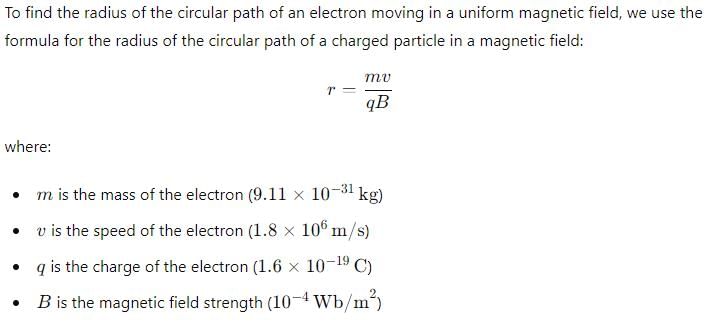
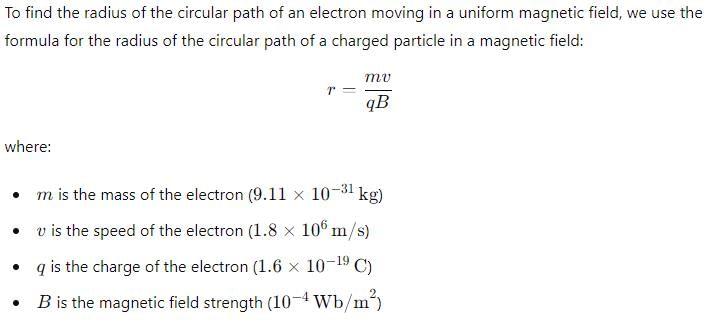
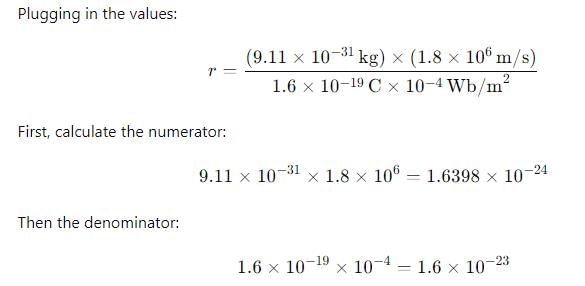
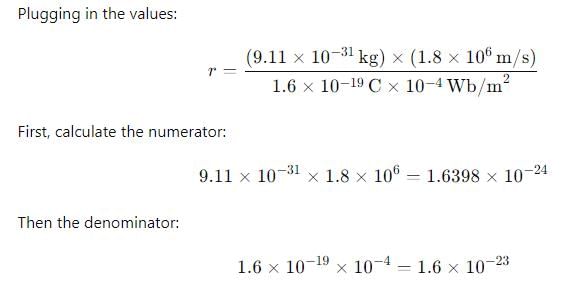
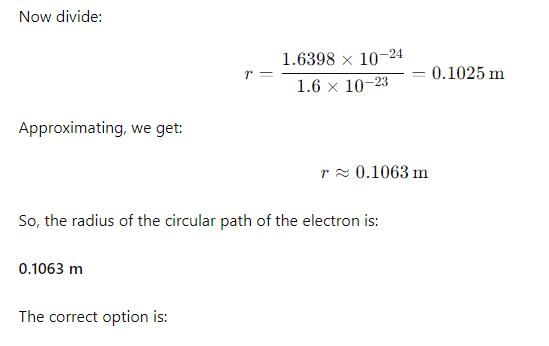
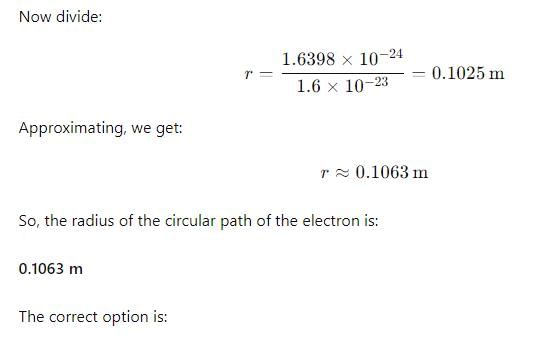
4. 0.1063 m
An electron and proton enter a magnetic field with equal velocities. Which one of them experiences a greater force?- a)electron
- b)proton
- c)Both experience same magnitude of force
- d)No prediction can be made.
Correct answer is option 'C'. Can you explain this answer?
An electron and proton enter a magnetic field with equal velocities. Which one of them experiences a greater force?
a)
electron
b)
proton
c)
Both experience same magnitude of force
d)
No prediction can be made.

|
Divey Sethi answered |
As charges and velocities are same
F=q(V×B)
So having the same magnitude of charge and same velocity, they'll experience the same magnitude of force.
F=q(V×B)
So having the same magnitude of charge and same velocity, they'll experience the same magnitude of force.
Two concentric coils carry the same current in opposite directions. The diameter of the inner coil is half that of the outer coil. If the magnetic field produced by the outer coil at the common centre are 1 T, the net field at the centre is
- a)4T
- b)2T
- c)1T
- d)3T
Correct answer is option 'C'. Can you explain this answer?
Two concentric coils carry the same current in opposite directions. The diameter of the inner coil is half that of the outer coil. If the magnetic field produced by the outer coil at the common centre are 1 T, the net field at the centre is
a)
4T
b)
2T
c)
1T
d)
3T
|
|
Krishna Iyer answered |
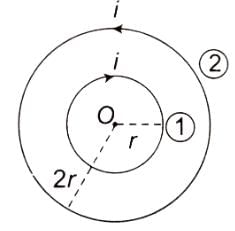
The magnetic field produced by a current-carrying coil at its center is given by the formula,
B = μ0 * (N*I/R),
where,
B is the magnetic field,
μ0 is the permeability of free space,
N is the number of turns in the coil,
I is the current through the coil, and
R is the radius of the coil.
In this case, both the coils carry the same current but in opposite directions. So, the fields produced by them will be in opposite directions. Also, the diameter of the inner coil is half that of the outer coil. Thus, the radius of the inner coil will be half that of the outer coil.
Therefore, the field at the center due to the inner coil will be double that due to the outer coil (because the magnetic field is inversely proportional to the radius).
Since the fields are in opposite directions, the net field at the center will be the difference between the two fields. That is, 2B (due to the inner coil) - B (due to the outer coil) = B.
So, if the field due to the outer coil is 1 T (Tesla), the net field at the center will also be 1 T.
Hence, the correct answer is 3. 1T.
Ampere’s circuital law is analogous to a law in electrostatics.That law is- a)Gauss’s law
- b)Kirchhoff’s law
- c)Faraday’s law
- d)Coulomb’s law
Correct answer is option 'A'. Can you explain this answer?
Ampere’s circuital law is analogous to a law in electrostatics.That law is
a)
Gauss’s law
b)
Kirchhoff’s law
c)
Faraday’s law
d)
Coulomb’s law
|
|
Vijay Bansal answered |
Ampere's law is similar to Guass's law in electrostatics.
Guass's law corelates surface integral of electric field E with charge q over a surface.
Ampere's law corelates the line integral of magnetic field B with current over a closed path.
The magnetic field due to circular coil of 200 turns of diameter 0.1m carrying a current of 5A at a point on the axis of the coil at a distance 0.15m from the center of the coil will be- a)

- b)

- c)

- d)

Correct answer is option 'D'. Can you explain this answer?
The magnetic field due to circular coil of 200 turns of diameter 0.1m carrying a current of 5A at a point on the axis of the coil at a distance 0.15m from the center of the coil will be
a)
b)
c)
d)
|
|
Krishna Iyer answered |
B=μ02πnIa2/4π (a2+x2)3/2
=10−7×2×(22/7)×200×5×(0⋅1/2)2/ [(0⋅1/2)2+(0⋅15)2]3/2
=39.74x10-5
=10−7×2×(22/7)×200×5×(0⋅1/2)2/ [(0⋅1/2)2+(0⋅15)2]3/2
=39.74x10-5
In the figure shown, what is ? The magnitude of current is the same in all three wires.
? The magnitude of current is the same in all three wires.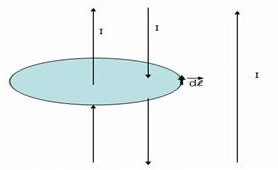
- a)2I
- b)–I
- c)I
- d)Zero
Correct answer is option 'D'. Can you explain this answer?
In the figure shown, what is ? The magnitude of current is the same in all three wires.
? The magnitude of current is the same in all three wires.
a)
2I
b)
–I
c)
I
d)
Zero

|
Yogesh Singla answered |
It is equal to the total current threading the loop which is equal to zero hence option D is correct
If a long hollow copper pipe carries a direct current, the magnetic field associated with the current will be- a)only outside the pipe
- b)only inside the pipe
- c)neither outside nor inside the pipe
- d)both inside and outside the pipe
Correct answer is option 'A'. Can you explain this answer?
If a long hollow copper pipe carries a direct current, the magnetic field associated with the current will be
a)
only outside the pipe
b)
only inside the pipe
c)
neither outside nor inside the pipe
d)
both inside and outside the pipe
|
|
Hansa Sharma answered |
For a loop inside the hollow portion of the conductor, the current enclosed is zero until the loop is on the surface or inside the material of the conductor.
∴Binside=0
For any loop outside, current enclosed by the amperian loop is not zero, hence the magnetic field is non-zero.
∴Binside=0
For any loop outside, current enclosed by the amperian loop is not zero, hence the magnetic field is non-zero.
A proton with 1MeV kinetic energy is moving in a circular path of radius R in a uniform magnetic field. What should be the energy of an α – particle to describe a circle of same radius in the same magnetic field?- a)2 MeV
- b)0.5 MeV
- c)1 MeV
- d)4 MeV
Correct answer is option 'C'. Can you explain this answer?
A proton with 1MeV kinetic energy is moving in a circular path of radius R in a uniform magnetic field. What should be the energy of an α – particle to describe a circle of same radius in the same magnetic field?
a)
2 MeV
b)
0.5 MeV
c)
1 MeV
d)
4 MeV

|
Shraddha Singh answered |
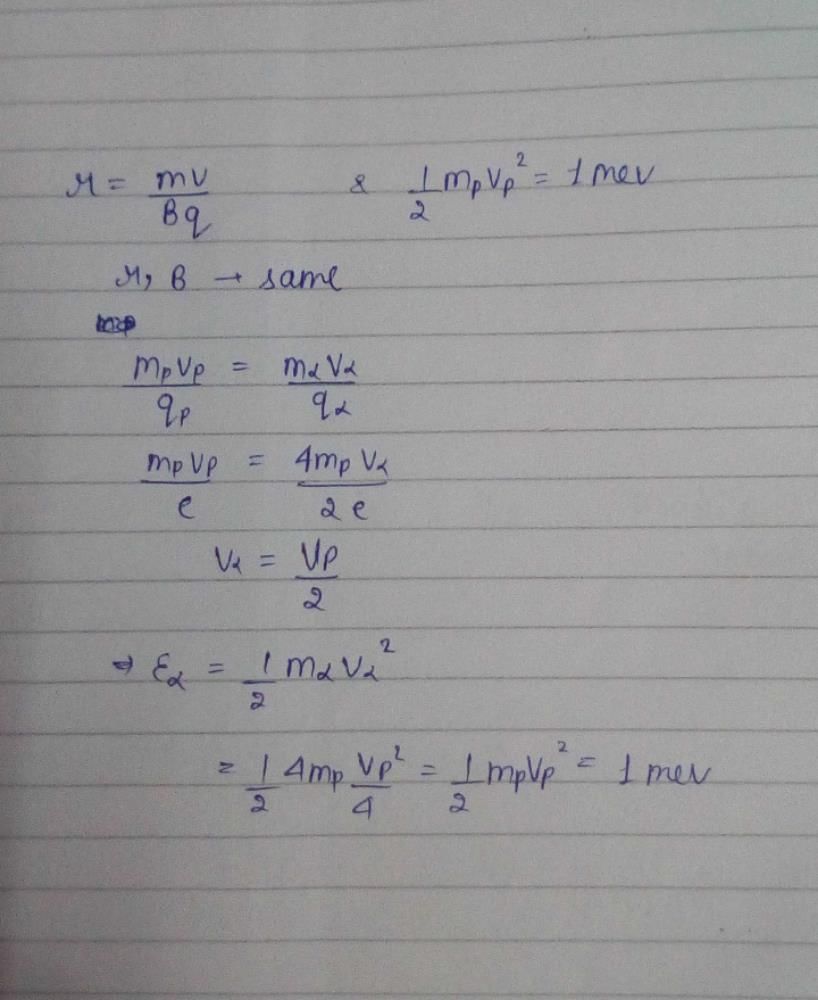
Wire of length l, carries a steady current I. It is bent first to form a circular coil of one turn. The same wire of same length is now bent more sharply to give two loops of smaller radius the magnetic field at the centre caused by the same current is- a)one third of its initial value
- b)nine times of its initial value
- c)four times of its initial value
- d)unaltered
Correct answer is option 'C'. Can you explain this answer?
Wire of length l, carries a steady current I. It is bent first to form a circular coil of one turn. The same wire of same length is now bent more sharply to give two loops of smaller radius the magnetic field at the centre caused by the same current is
a)
one third of its initial value
b)
nine times of its initial value
c)
four times of its initial value
d)
unaltered
|
|
Om Desai answered |
Let the radii be r1 and r2 respectively.
Since there are two turns of radius r2, r1=2r2
Magnetic field B at the centre of the coil of radius r1 B1=μoi/2r1=μoi/4r2
Magnetic field B at the center of the coil of radius r2 B2=2×μoi/2r2
∴ B2/B1 =(2× μoi/2r2)/(μoi /4r2) =4
Hence the answer is option C, four times its initial value.
Since there are two turns of radius r2, r1=2r2
Magnetic field B at the centre of the coil of radius r1 B1=μoi/2r1=μoi/4r2
Magnetic field B at the center of the coil of radius r2 B2=2×μoi/2r2
∴ B2/B1 =(2× μoi/2r2)/(μoi /4r2) =4
Hence the answer is option C, four times its initial value.
Ratio of magnetic force Fm and electric force Fe acting on a charge getting undeflected through the field is- a)E/B
- b)B/E
- c)1
- d)0
Correct answer is option 'C'. Can you explain this answer?
Ratio of magnetic force Fm and electric force Fe acting on a charge getting undeflected through the field is
a)
E/B
b)
B/E
c)
1
d)
0
|
|
Lavanya Menon answered |
if the particle is undeflected, then the magnetic force equals the electric force:
q x v x B=q x E
B is the magnitude of the magnetic field
E is the magnitude of the electric field
v is the magnitude of the velocity of the particle.
If the forces are equal then:
v=E/B
For undeflected v=1
E/B=1
q x v x B=q x E
B is the magnitude of the magnetic field
E is the magnitude of the electric field
v is the magnitude of the velocity of the particle.
If the forces are equal then:
v=E/B
For undeflected v=1
E/B=1
The frequency (v) of charged particle, moving at right angles to the magnetic field is independent of- a)radius of circular trajectory (r)
- b)magnetic induction (B)
- c)speed of the particle (v)
- d)both speed of the particle (v) and radius of trajectory (r).
Correct answer is option 'D'. Can you explain this answer?
The frequency (v) of charged particle, moving at right angles to the magnetic field is independent of
a)
radius of circular trajectory (r)
b)
magnetic induction (B)
c)
speed of the particle (v)
d)
both speed of the particle (v) and radius of trajectory (r).

|
Infinity Academy answered |
Frequency (v) = qB/2πm.
Frequency is independent of radius of trajectory of particle and speed of particle.
Frequency is independent of radius of trajectory of particle and speed of particle.
A 2 cm long copper wire having mass of 6 gm, dips in to two mercury pools to form a complete circuit. The wire is placed between the poles of a magnet which causes a field strength of 0.3 T. Find the initial upward acceleration of copper wire after 100 A of current is passed through the wire (g = 10 m/s2)- a)1 m/s2
- b)10 m/s2
- c)100 m/s2
- d)90 m/s2
Correct answer is option 'D'. Can you explain this answer?
A 2 cm long copper wire having mass of 6 gm, dips in to two mercury pools to form a complete circuit. The wire is placed between the poles of a magnet which causes a field strength of 0.3 T. Find the initial upward acceleration of copper wire after 100 A of current is passed through the wire (g = 10 m/s2)
a)
1 m/s2
b)
10 m/s2
c)
100 m/s2
d)
90 m/s2
|
|
Hansa Sharma answered |
ma=Bil−mg
a=0.3×100×2×10−2−10×6×10−3/ m
a= 0.6−0.06/6×10−3
=100−10
=90ms−2
a=0.3×100×2×10−2−10×6×10−3/ m
a= 0.6−0.06/6×10−3
=100−10
=90ms−2
A particle of charge 1.6 x 10-19 C and mass 1.8 x 10-27 kg is moving around the path of radius 2 x 104 m with velocity 2.4 x 106 m/s. The magnetic field necessary is (in Wb/m²)- a)13.5 x 10-6
- b)135 x 10-6
- c)0.135 x 10
- d)1.35 x 10-6
Correct answer is option 'D'. Can you explain this answer?
A particle of charge 1.6 x 10-19 C and mass 1.8 x 10-27 kg is moving around the path of radius 2 x 104 m with velocity 2.4 x 106 m/s. The magnetic field necessary is (in Wb/m²)
a)
13.5 x 10-6
b)
135 x 10-6
c)
0.135 x 10
d)
1.35 x 10-6
|
|
Sreemoyee Choudhury answered |
Explanation:
When an electron is projected in a uniform electric field and a uniform magnetic field, both pointing in the same direction as the electron's velocity, the following happens:
1. Electric field:
The electric field exerts a force on the electron in the direction of the field. Since the electron is negatively charged, it experiences a force opposite to the direction of the electric field. Therefore, the electric field does not affect the direction of the electron's motion.
2. Magnetic field:
The magnetic field exerts a force on the electron perpendicular to both the field direction and the electron's velocity. The force is given by the Lorentz force equation:
F = q(v x B)
where F is the force, q is the charge of the electron, v is its velocity, and B is the magnetic field.
In this case, the force is directed inward, towards the center of the circular path. The magnitude of the force is given by:
|F| = qvB
where |F| is the magnitude of the force.
Since the force is perpendicular to the velocity, it causes the electron to move in a circular path around the magnetic field lines. The radius of the path is given by:
r = mv/qB
where r is the radius of the path, m is the mass of the electron, and v is its velocity.
3. Combined effect:
Since the electric field does not affect the direction of the electron's motion, the only effect is due to the magnetic field. As the electron moves in a circular path, it loses kinetic energy due to the work done by the magnetic force. Therefore, its velocity decreases in magnitude.
Hence, the correct option is D- The electron velocity will decrease in magnitude.
When an electron is projected in a uniform electric field and a uniform magnetic field, both pointing in the same direction as the electron's velocity, the following happens:
1. Electric field:
The electric field exerts a force on the electron in the direction of the field. Since the electron is negatively charged, it experiences a force opposite to the direction of the electric field. Therefore, the electric field does not affect the direction of the electron's motion.
2. Magnetic field:
The magnetic field exerts a force on the electron perpendicular to both the field direction and the electron's velocity. The force is given by the Lorentz force equation:
F = q(v x B)
where F is the force, q is the charge of the electron, v is its velocity, and B is the magnetic field.
In this case, the force is directed inward, towards the center of the circular path. The magnitude of the force is given by:
|F| = qvB
where |F| is the magnitude of the force.
Since the force is perpendicular to the velocity, it causes the electron to move in a circular path around the magnetic field lines. The radius of the path is given by:
r = mv/qB
where r is the radius of the path, m is the mass of the electron, and v is its velocity.
3. Combined effect:
Since the electric field does not affect the direction of the electron's motion, the only effect is due to the magnetic field. As the electron moves in a circular path, it loses kinetic energy due to the work done by the magnetic force. Therefore, its velocity decreases in magnitude.
Hence, the correct option is D- The electron velocity will decrease in magnitude.
A conductor of length l, carrying current I and placed in a magnetic field B experiences a force F given by- a)

- b)

- c)

- d)

Correct answer is option 'C'. Can you explain this answer?
A conductor of length l, carrying current I and placed in a magnetic field B experiences a force F given by
a)
b)
c)
d)

|
Deepali Tripathi answered |
F=q(v x B)
=q(dl/dt x B)
=q/dt(l x B)
=i(l x B)
=q(dl/dt x B)
=q/dt(l x B)
=i(l x B)
A circular coil of radius r carries current I. The magnetic field at its center is B. at what distance from the center on the axis of the coil magnetic field will be B/8- a)√3R
- b)√2R
- c)2R
- d)3R
Correct answer is option 'A'. Can you explain this answer?
A circular coil of radius r carries current I. The magnetic field at its center is B. at what distance from the center on the axis of the coil magnetic field will be B/8
a)
√3R
b)
√2R
c)
2R
d)
3R

|
Shilpa Saha answered |
As you know that magnetic field at point on the axis of current carrying ring is


where x is the point on the axis of ring, R is the radius of ring , i is the current carrying on ring and N is the number of turns .
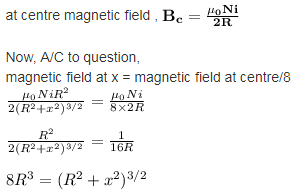
This is possible only when x = +-√3R
Hence, √3R distance from the centre magnetic field is equal to magnetic field at centre .
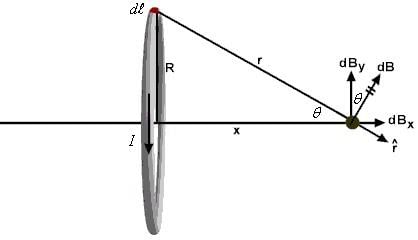

A charged particle is moving on circular path with velocity v in a uniform magnetic field B, if the velocity of the charged particle is doubled and strength of Magnetic field is halved, then radius becomes- a)8 times
- b)4 times
- c)2 times
- d)16 times
Correct answer is option 'B'. Can you explain this answer?
A charged particle is moving on circular path with velocity v in a uniform magnetic field B, if the velocity of the charged particle is doubled and strength of Magnetic field is halved, then radius becomes
a)
8 times
b)
4 times
c)
2 times
d)
16 times
|
|
Meera Singh answered |
As 
According to the question, v‘ = 2v and B' = B/2
∴

According to the question, v‘ = 2v and B' = B/2
∴

If a charged particle goes undeflected in a region containing electric and magnetic fields. Select all of the following statements that must be true for this.1.  must be perpendicular to
must be perpendicular to
2.  must be perpendicular to
must be perpendicular to
3. E must be perpendicular to u B.
4.  must be perpendicular to
must be perpendicular to
- a)1 and 3 only
- b)1 only
- c)1 and 2 only
- d)2 only
Correct answer is option 'A'. Can you explain this answer?
If a charged particle goes undeflected in a region containing electric and magnetic fields. Select all of the following statements that must be true for this.
1.  must be perpendicular to
must be perpendicular to
2. must be perpendicular to
must be perpendicular to
3. E must be perpendicular to u B.
4. must be perpendicular to
must be perpendicular to
2.
3. E must be perpendicular to u B.
4.
a)
1 and 3 only
b)
1 only
c)
1 and 2 only
d)
2 only
|
|
Lavanya Menon answered |
If a charged particle goes unaccelerated in a region containing
electric and magnetic fields,
electric and magnetic fields,

The force acting on a charge q moving with velocity in a magnetic field
in a magnetic field is given by
is given by- a)

- b)

- c)

- d)

Correct answer is option 'C'. Can you explain this answer?
The force acting on a charge q moving with velocity in a magnetic field
in a magnetic field is given by
is given by
a)
b)
c)
d)
|
|
Neha Sharma answered |
The magnetic force on a free moving charge is perpendicular to both the velocity of the charge and the magnetic field with direction given by the right hand rule . The force is given by the charge times the vector product of velocity and magnetic field.
The force between two current carrying conductors is due to which of the following- a)Magnetic effect of electric current
- b)Electrostatic interaction
- c)Electromagnetic induction
- d)Polarisation
Correct answer is option 'A'. Can you explain this answer?
The force between two current carrying conductors is due to which of the following
a)
Magnetic effect of electric current
b)
Electrostatic interaction
c)
Electromagnetic induction
d)
Polarisation

|
Virat answered |
Current carring wire produce magnetic field
Which of the following laws give the direction of induced e.m.f- a)Faraday’s Law
- b)Ampere’s Theorem
- c)Biot Savart Law
- d)Lenz’s Law
Correct answer is option 'D'. Can you explain this answer?
Which of the following laws give the direction of induced e.m.f
a)
Faraday’s Law
b)
Ampere’s Theorem
c)
Biot Savart Law
d)
Lenz’s Law

|
Knowledge Hub answered |
Lenz’s law is used for determining the direction of induced current.
Lenz’s law of electromagnetic induction states that the direction of induced current in a given magnetic field is such that it opposes the induced change by changing the magnetic field.
Following is the formula of Lenz’s law:
ϵ=−N (∂ϕB/∂t)
Where,
- ε is the induced emf
- ∂ΦB is the change in magnetic flux
- N is the number of turns in the coil
Lenz’s law finds application in electromagnetic braking and in electric generators
A Charge is fired through a magnetic field. The magnetic force acting on it is maximum when the angle between the direction of motion and magnetic field is- a)π
- b)zero
- c)π/2
- d)π/4
Correct answer is option 'C'. Can you explain this answer?
A Charge is fired through a magnetic field. The magnetic force acting on it is maximum when the angle between the direction of motion and magnetic field is
a)
π
b)
zero
c)
π/2
d)
π/4
|
|
Krishna Iyer answered |
The force will have a magnitude F=qvB sin q, thus it will be maximum if sin q is maximum. Thus, angle between velocity and magnetic field should be 90o or the charge particle moves perpendicular to the velocity vector.
A rectangular loop carrying a current I is situated near a long straight wire such that the wire is parallel to the one of the sides of the loop and is in a plane of the loop. If a steady current I is established in wire as shown in figure, the loop will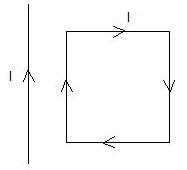
- a)move away from the wire or towards right
- b)remain stationary
- c)rotate about an axis parallel to the wire
- d)move towards the wire
Correct answer is option 'D'. Can you explain this answer?
A rectangular loop carrying a current I is situated near a long straight wire such that the wire is parallel to the one of the sides of the loop and is in a plane of the loop. If a steady current I is established in wire as shown in figure, the loop will
a)
move away from the wire or towards right
b)
remain stationary
c)
rotate about an axis parallel to the wire
d)
move towards the wire

|
Top Rankers answered |
The long straight wire and side AB carry current in the same direction, hence will attract each other.
The long straight wire and side CD carry current in the opposite direction, hence will repel each other.
Force on side BC will be equal and opposite to force on side DA.
Since CD is farther from the wire than AB, the force of attraction on AB will exceed the force of repulsion on CD.
Hence, there will be a net force of attraction on the loop ABCD and it will move towards the wire.
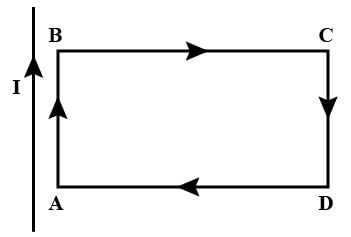
The long straight wire and side CD carry current in the opposite direction, hence will repel each other.
Force on side BC will be equal and opposite to force on side DA.
Since CD is farther from the wire than AB, the force of attraction on AB will exceed the force of repulsion on CD.
Hence, there will be a net force of attraction on the loop ABCD and it will move towards the wire.

When a charged particle enters a magnetic field in a direction perpendicular to the field, which one of the following does not change?- a)velocity of the particle.
- b)mass of the particle.
- c)energy of the particle.
- d)momentum of the particle
Correct answer is option 'C'. Can you explain this answer?
When a charged particle enters a magnetic field in a direction perpendicular to the field, which one of the following does not change?
a)
velocity of the particle.
b)
mass of the particle.
c)
energy of the particle.
d)
momentum of the particle
|
|
Geetika Shah answered |
The magnetic force acts perpendicular to the velocity of the particle. This causes circular motion. In the magnetic field the speed and kinetic energy of the particle remain constant, but the direction is altered at each instant by the perpendicular magnetic force.
A wire of length l, carrying current is bent into a loop and placed with its plane perpendicular to a magnetic field. In which of the following shapes, is the torque acting on the loop maximum?- a)Rectangle
- b)Circle
- c)Square
- d)Equilateral triangle
Correct answer is option 'B'. Can you explain this answer?
A wire of length l, carrying current is bent into a loop and placed with its plane perpendicular to a magnetic field. In which of the following shapes, is the torque acting on the loop maximum?
a)
Rectangle
b)
Circle
c)
Square
d)
Equilateral triangle
|
|
Om Desai answered |
The torque on a current loop depends upon the area of the current loop, when the magnetic field is perpendicular to the plane of the loops the torque has its maximum value,
Τ=I A B
We know I and B for all these cases but A depends upon the geometry. The circle has the greatest area so it should provide the greatest torque.
Τ=I A B
We know I and B for all these cases but A depends upon the geometry. The circle has the greatest area so it should provide the greatest torque.
A straight conductor carrying current I is split into circular loop as shown in figure a , the magnetic induction at the center of the circular loop is
- a)Zero
- b)

- c)

- d)Infinite
Correct answer is option 'A'. Can you explain this answer?
A straight conductor carrying current I is split into circular loop as shown in figure a , the magnetic induction at the center of the circular loop is
a)
Zero
b)
c)
d)
Infinite
|
|
Jayant Mishra answered |
The magnetic field at the center O due to the upper side of the semicircular current loop is equal and opposite to that due to the lower side of the loop.
In a current carrying conductor varying electric field generates- a)Magnetic field
- b)Potential gradient
- c)Resistance
- d)Current
Correct answer is option 'A'. Can you explain this answer?
In a current carrying conductor varying electric field generates
a)
Magnetic field
b)
Potential gradient
c)
Resistance
d)
Current
|
|
Animesh Nhagal answered |
Moving electrons in conducter produce electromagnetic wave...
When a charged particle moves in a magnetic field, its kinetic energy always- a)remain constant
- b)first increases then decreases.
- c)decreases
- d)increases
Correct answer is option 'A'. Can you explain this answer?
When a charged particle moves in a magnetic field, its kinetic energy always
a)
remain constant
b)
first increases then decreases.
c)
decreases
d)
increases
|
|
Rajeev Saxena answered |
The magnetic field does no work, so the kinetic energy and speed of a charged particle in a magnetic field remain constant. The magnetic force, acting perpendicular to the velocity of the particle, will cause circular motion.
A solenoid coil of 300 turns /m is carrying a current of 5 A. Calculate the magnitude of magnetic intensity inside the solenoid.- a)1.9 T
- b)1.9 X 10-6 T
- c)1.9 X 10-3 T
- d)1.9 X 10-7 T
Correct answer is option 'C'. Can you explain this answer?
A solenoid coil of 300 turns /m is carrying a current of 5 A. Calculate the magnitude of magnetic intensity inside the solenoid.
a)
1.9 T
b)
1.9 X 10-6 T
c)
1.9 X 10-3 T
d)
1.9 X 10-7 T
|
|
Jyoti Sengupta answered |
We know, Magnetic field of solenoid,
= μonI
=4πx10-7x300x5
=4πx15x10-5
=6πx10-9
=18.89x10-9
≈1.9x10-3T
= μonI
=4πx10-7x300x5
=4πx15x10-5
=6πx10-9
=18.89x10-9
≈1.9x10-3T
Along an infinitely long conductor carrying a current of 8 A we keep another conductor of length 5 m carrying a current of 3 A. Both the conductors are 10 cm apart. Find the force on small conductor.- a)2.4 X 10-4 N
- b)9.6 X 10-4 N
- c)2.6 X 10-6 N
- d)9.6 X 10-5 N
Correct answer is option 'A'. Can you explain this answer?
Along an infinitely long conductor carrying a current of 8 A we keep another conductor of length 5 m carrying a current of 3 A. Both the conductors are 10 cm apart. Find the force on small conductor.
a)
2.4 X 10-4 N
b)
9.6 X 10-4 N
c)
2.6 X 10-6 N
d)
9.6 X 10-5 N
|
|
Shreya Singh answered |
F=4π×10^-7 i1 i2 l/2π rF= 4π × 10^-7×8×3× 5./2π×10^-2.F= 2×10^-7×8×3× 5 ×100.F=2.4×10^-4.
Time taken by an ion to describe a semicircular path, in a cyclotron- a)Depends upon the electric field.
- b)depends upon the radius of the circular path.
- c)depends upon speed of ion.
- d)is constant.
Correct answer is option 'D'. Can you explain this answer?
Time taken by an ion to describe a semicircular path, in a cyclotron
a)
Depends upon the electric field.
b)
depends upon the radius of the circular path.
c)
depends upon speed of ion.
d)
is constant.

|
Pragati Dey answered |
As the speed of the ions increases, its mass also increases according to the relation-

Where m0 = the rest mass of the ion
m = the mass of ion while moving with velocity
c = velocity of light.
Now, the time taken by the ion to describe semicircular path is given by

It shows that as v increases, t increases. It means that the positive ion will take longer time to describe semicircular path than the time for half cycle of oscillating electric field. As a result, the ion will not arrive in the gap between the two dees exactly at the instant; the polarity of the two dees is reversed and hence will not be accelerated further.
Two straight horizontal parallel wires are carrying the same current in same direction, d is the distnace between the wires. You are povided with a small freely suspended magnetic needle. At which of the following positions will the orientation of the needle be independent of the magnitude of current in the wires?- a)At a distance d/2 from any of the wires.
- b)At a distance d/2 from any of the wires in the horizontal plane.
- c)Anywhere on the circumference of a vertical circle of radius d ans centre half way between the wires.
- d)At points half way between the wires in the horizontal plane.
Correct answer is option 'A'. Can you explain this answer?
Two straight horizontal parallel wires are carrying the same current in same direction, d is the distnace between the wires. You are povided with a small freely suspended magnetic needle. At which of the following positions will the orientation of the needle be independent of the magnitude of current in the wires?
a)
At a distance d/2 from any of the wires.
b)
At a distance d/2 from any of the wires in the horizontal plane.
c)
Anywhere on the circumference of a vertical circle of radius d ans centre half way between the wires.
d)
At points half way between the wires in the horizontal plane.
|
|
Nandini Patel answered |
The answer is d.
At these points, the resultant field =0
At these points, the resultant field =0
A circular loop of radius 0.0157 m carries a current of 2 A. The magnetic field at the centre of the loop is- a)3.14 x 10-5 weber /m2
- b)1.57 x 10-5 weber /m2
- c)1.57 x 10-5 weber /m2
- d)8.0 x 10-5 weber /m2
Correct answer is option 'D'. Can you explain this answer?
A circular loop of radius 0.0157 m carries a current of 2 A. The magnetic field at the centre of the loop is
a)
3.14 x 10-5 weber /m2
b)
1.57 x 10-5 weber /m2
c)
1.57 x 10-5 weber /m2
d)
8.0 x 10-5 weber /m2
|
|
Hansa Sharma answered |
The magnetic field due to a circular loop is given by:
B= μ02πi/4πr
=10−7×2π×2/0.0157
=8×10−5 Wb/m2
B= μ02πi/4πr
=10−7×2π×2/0.0157
=8×10−5 Wb/m2
The magnetic field inside a toroid of radius R is B. If the current through it is doubled and the radius increased four times keeping the number of turns per unit length same, then the magnetic field produced by it will be- a)B
- b)2B
- c)4B
- d)B/2
Correct answer is option 'B'. Can you explain this answer?
The magnetic field inside a toroid of radius R is B. If the current through it is doubled and the radius increased four times keeping the number of turns per unit length same, then the magnetic field produced by it will be
a)
B
b)
2B
c)
4B
d)
B/2
|
|
Nandini Iyer answered |
In the 1st case,
B1= μ0Ni/2πr
In the 2nd case,
B2= μ0N2i/2π4r
Comparing both of them,
μ0Ni/2πr=μ0N2i/2π4r
B1=B2/2
B2=2B1
B1= μ0Ni/2πr
In the 2nd case,
B2= μ0N2i/2π4r
Comparing both of them,
μ0Ni/2πr=μ0N2i/2π4r
B1=B2/2
B2=2B1
The constant μo is called- a)Absolute Permeability
- b)Coefficient of mutual induction
- c)Coefficient of self induction
- d)Relative permeability
Correct answer is option 'A'. Can you explain this answer?
The constant μ
o
is calleda)
Absolute Permeability
b)
Coefficient of mutual induction
c)
Coefficient of self induction
d)
Relative permeability
|
|
Harsh Singhal answered |
B&c direct wrong
now for d relative permeability is Ur/U0
now for d relative permeability is Ur/U0
In two current carrying conductors parallel currents________, anti parallel currents_________ .- a)attract , attract
- b)attract , repel
- c)repel , attract
- d)repel , repel
Correct answer is option 'B'. Can you explain this answer?
In two current carrying conductors parallel currents________, anti parallel currents_________ .
a)
attract , attract
b)
attract , repel
c)
repel , attract
d)
repel , repel
|
|
Pooja Mehta answered |
Two current carrying straight conductors placed near each other will exert (magnetic) forces on each other due to magnetic field of each other. ... Note − Parallel current carrying wires attract, and anti-parallel current carrying wires repel each other.
The connecting wires of a battery of an automobile carry 200 A of current. Calculate the force per unit length between the wires if they are 50 cm long and 2 cm apart?- a)4Nm-1
- b)0.4Nm-1
- c)0.04Nm-1
- d)40Nm-1
Correct answer is option 'B'. Can you explain this answer?
The connecting wires of a battery of an automobile carry 200 A of current. Calculate the force per unit length between the wires if they are 50 cm long and 2 cm apart?
a)
4Nm-1
b)
0.4Nm-1
c)
0.04Nm-1
d)
40Nm-1
|
|
Keerthana Chakraborty answered |
Given parameters:
Current, I = 200 A
Length of the wire, l = 50 cm = 0.5 m
Distance between the wires, d = 2 cm = 0.02 m
To find: Force per unit length between the wires
Formula used: Magnetic force per unit length between two parallel conductors is given by the formula:
F/L = μ0 I1 I2 / 2πd
Where
F/L = force per unit length
μ0 = permeability of free space = 4π x 10^-7 Tm/A
I1, I2 = current in the two wires
d = distance between the wires
Substituting the given values in the above formula, we get:
F/L = (4π x 10^-7 Tm/A) x (200 A)^2 / 2π x 0.02 m
F/L = 0.4 N/m
Therefore, the force per unit length between the wires is 0.4 N/m, which is option (b).
Current, I = 200 A
Length of the wire, l = 50 cm = 0.5 m
Distance between the wires, d = 2 cm = 0.02 m
To find: Force per unit length between the wires
Formula used: Magnetic force per unit length between two parallel conductors is given by the formula:
F/L = μ0 I1 I2 / 2πd
Where
F/L = force per unit length
μ0 = permeability of free space = 4π x 10^-7 Tm/A
I1, I2 = current in the two wires
d = distance between the wires
Substituting the given values in the above formula, we get:
F/L = (4π x 10^-7 Tm/A) x (200 A)^2 / 2π x 0.02 m
F/L = 0.4 N/m
Therefore, the force per unit length between the wires is 0.4 N/m, which is option (b).
The horizontal component of earth's magnetic field at a certain place is 3.0 x 10-5 T and having a direction from the geographic south to geographic north. The force per unit length on a very long straight conductor carrying a steady current of 1.2 A in east to west direction is- a)3.0 x 10-5 N m-1
- b)3.2 x 10-5 N m-1
- c)3.6 x 10-5 N m-1
- d)3.8 x 10-5 N m-1
Correct answer is option 'C'. Can you explain this answer?
The horizontal component of earth's magnetic field at a certain place is 3.0 x 10-5 T and having a direction from the geographic south to geographic north. The force per unit length on a very long straight conductor carrying a steady current of 1.2 A in east to west direction is
a)
3.0 x 10-5 N m-1
b)
3.2 x 10-5 N m-1
c)
3.6 x 10-5 N m-1
d)
3.8 x 10-5 N m-1
|
|
Anjali Sharma answered |
Force per unit length f = F/l = IB sinθ
when the current is flowing from east to west then θ = 90°, hence
f = IBsin 90° = 1.2 x 3 x 10-5 x 1 = 3.6 x 10-5 N m-1.
when the current is flowing from east to west then θ = 90°, hence
f = IBsin 90° = 1.2 x 3 x 10-5 x 1 = 3.6 x 10-5 N m-1.
A charged particle is moving in a cyclotron, what effect on the radius of path of this charged particle will occur when the frequency of the radio frequency field is doubled?- a)It will also be doubled.
- b)It will be halved.
- c)It will be increased by four times.
- d)It will remain unchanged.
Correct answer is option 'D'. Can you explain this answer?
A charged particle is moving in a cyclotron, what effect on the radius of path of this charged particle will occur when the frequency of the radio frequency field is doubled?
a)
It will also be doubled.
b)
It will be halved.
c)
It will be increased by four times.
d)
It will remain unchanged.
|
|
Meera Singh answered |
As frequency of revolution in a cyclotron
vC = Bq/2πm is independent of r.
So the radius of path in the dees will remain unchanged. When the frequency is changed.
vC = Bq/2πm is independent of r.
So the radius of path in the dees will remain unchanged. When the frequency is changed.
A tightly wound 90 turn coil of radius 15 cm has a magnetic field of 4 x 10-4 T at its centre. The current flowing through it is- a)1.06 A
- b)2.44 A
- c)3.44 A
- d)4.44 A
Correct answer is option 'A'. Can you explain this answer?
A tightly wound 90 turn coil of radius 15 cm has a magnetic field of 4 x 10-4 T at its centre. The current flowing through it is
a)
1.06 A
b)
2.44 A
c)
3.44 A
d)
4.44 A
|
|
Raghav Bansal answered |
Here, N = 90
R = 15 cm = 15 x 10-2m, B = 4 x 10-4 T
∵ B = μ0NI/2R

R = 15 cm = 15 x 10-2m, B = 4 x 10-4 T
∵ B = μ0NI/2R

Directions: These questions consist of two statements, each printed as Assertion and Reason. While answering these questions, you are required to choose any one of the following four responses.Assertion: The magnetic field produced by a current carrying solenoid is independent of its length and cross-sectional area.Reason: The magnetic field inside the solenoid is uniform.- a)If both Assertion and Reason are correct and the Reason is a correct explanation of the Assertion.
- b)If both Assertion and Reason are correct but Reason is not a correct explanation of the Assertion.
- c)If the Assertion is correct but Reason is incorrect.
- d)If both the Assertion and Reason are incorrect.
Correct answer is option 'B'. Can you explain this answer?
Directions: These questions consist of two statements, each printed as Assertion and Reason. While answering these questions, you are required to choose any one of the following four responses.
Assertion: The magnetic field produced by a current carrying solenoid is independent of its length and cross-sectional area.
Reason: The magnetic field inside the solenoid is uniform.
a)
If both Assertion and Reason are correct and the Reason is a correct explanation of the Assertion.
b)
If both Assertion and Reason are correct but Reason is not a correct explanation of the Assertion.
c)
If the Assertion is correct but Reason is incorrect.
d)
If both the Assertion and Reason are incorrect.
|
|
Gowri Sen answered |
Assertion: The magnetic field produced by a current carrying solenoid is independent of its length and cross-sectional area.
Reason: The magnetic field inside the solenoid is uniform.
Explanation:
1. Magnetic field produced by a current carrying solenoid:
A solenoid is a coil of wire wound in the shape of a helix. When an electric current flows through the solenoid, it creates a magnetic field around it. The strength of this magnetic field depends on various factors, such as the number of turns in the coil, the current flowing through the coil, and the properties of the material used for the coil.
2. Magnetic field inside the solenoid:
The magnetic field inside a solenoid is considered to be uniform. This means that the magnetic field strength is the same at all points inside the solenoid. The reason for this uniformity is that the magnetic field lines inside a solenoid are closely packed and parallel to each other. The magnetic field lines run in a straight line from one end of the solenoid to the other, creating a uniform magnetic field inside.
3. Independence of magnetic field on length and cross-sectional area:
The assertion states that the magnetic field produced by a current carrying solenoid is independent of its length and cross-sectional area. This is indeed true because the magnetic field strength inside the solenoid is determined by the number of turns per unit length and the current flowing through the solenoid. These factors affect the magnetic field strength, but they are not directly dependent on the length or cross-sectional area of the solenoid.
4. Reason as a correct explanation:
The reason given in the statement is a correct explanation of the assertion. The uniform magnetic field inside the solenoid is a result of the closely packed and parallel magnetic field lines. This uniformity ensures that the magnetic field strength is the same at all points inside the solenoid, regardless of its length or cross-sectional area.
Conclusion:
In conclusion, the magnetic field produced by a current carrying solenoid is indeed independent of its length and cross-sectional area. The reason for this is the uniformity of the magnetic field inside the solenoid, which is a result of the closely packed and parallel magnetic field lines. Therefore, the correct answer to this question is option 'B' - both the assertion and reason are correct, and the reason is a correct explanation of the assertion.
Reason: The magnetic field inside the solenoid is uniform.
Explanation:
1. Magnetic field produced by a current carrying solenoid:
A solenoid is a coil of wire wound in the shape of a helix. When an electric current flows through the solenoid, it creates a magnetic field around it. The strength of this magnetic field depends on various factors, such as the number of turns in the coil, the current flowing through the coil, and the properties of the material used for the coil.
2. Magnetic field inside the solenoid:
The magnetic field inside a solenoid is considered to be uniform. This means that the magnetic field strength is the same at all points inside the solenoid. The reason for this uniformity is that the magnetic field lines inside a solenoid are closely packed and parallel to each other. The magnetic field lines run in a straight line from one end of the solenoid to the other, creating a uniform magnetic field inside.
3. Independence of magnetic field on length and cross-sectional area:
The assertion states that the magnetic field produced by a current carrying solenoid is independent of its length and cross-sectional area. This is indeed true because the magnetic field strength inside the solenoid is determined by the number of turns per unit length and the current flowing through the solenoid. These factors affect the magnetic field strength, but they are not directly dependent on the length or cross-sectional area of the solenoid.
4. Reason as a correct explanation:
The reason given in the statement is a correct explanation of the assertion. The uniform magnetic field inside the solenoid is a result of the closely packed and parallel magnetic field lines. This uniformity ensures that the magnetic field strength is the same at all points inside the solenoid, regardless of its length or cross-sectional area.
Conclusion:
In conclusion, the magnetic field produced by a current carrying solenoid is indeed independent of its length and cross-sectional area. The reason for this is the uniformity of the magnetic field inside the solenoid, which is a result of the closely packed and parallel magnetic field lines. Therefore, the correct answer to this question is option 'B' - both the assertion and reason are correct, and the reason is a correct explanation of the assertion.
Read the following text and answer the following questions on the basis of the same: TOROIDA toroid is a coil of insulated or enamelled wire wound on a donut-shaped form made of powdered iron. A toroid is used as an inductor in electronic circuits, especially at low frequencies where comparatively large inductances are necessary. A toroid has more inductance , for a given number of turns, than a solenoid with a core of the same material and similar size. This makes it possible to construct high-inductance coils of reasonable physical size and mass. Toroidal coils of a given inductance can carry more current than solenoidal coils of similar size, because larger-diameter wires can be used, and the total amount of wire is less, reducing the resistance . In a toroid, all the magnetic flux is contained in the core material. This is because the core has no ends from which flux might leak off. The confinement of the flux prevents external magnetic fields from affecting the behaviour of the toroid, and also prevents the magnetic field in the toroid from affecting other components in a circuit. Standard toroidal transformers typically offer a 95% efficiency, while standard laminated transformers typically offer less than a 90% rating. One of the most important differences between a toroidal transformer and a traditional laminated transformer is the absence of gaps. The leakage flux through the gaps contributes to the stray losses in the form of eddy currents (which is also expelled in the form of heat). A toroidal core doesn’t have an air gap. The core is tightly wound . The result is a stable, predictable toroidal core, free from discontinuities and holes. Audible vibration or hum in transformers is caused by vibration of the windings and core layers from the forces between the coil turns and core laminations. The toroidal transformer’s construction helps quiet this noise. In audio, or signal transmitting applications, unwarranted noise will affect sound quality, so a transformer with low audible vibration is ideal. For this reason, many sound system engineers prefer to use a toroidal transformer instead of a traditional laminated transformer.Efficiency of toroidal transformer is around ______ % which is ______ than laminated core transformer.- a)95, lower
- b)95, higher
- c)50, lower
- d)80, higher
Correct answer is option 'B'. Can you explain this answer?
Read the following text and answer the following questions on the basis of the same: TOROID
A toroid is a coil of insulated or enamelled wire wound on a donut-shaped form made of powdered iron. A toroid is used as an inductor in electronic circuits, especially at low frequencies where comparatively large inductances are necessary. A toroid has more inductance , for a given number of turns, than a solenoid with a core of the same material and similar size. This makes it possible to construct high-inductance coils of reasonable physical size and mass. Toroidal coils of a given inductance can carry more current than solenoidal coils of similar size, because larger-diameter wires can be used, and the total amount of wire is less, reducing the resistance . In a toroid, all the magnetic flux is contained in the core material. This is because the core has no ends from which flux might leak off. The confinement of the flux prevents external magnetic fields from affecting the behaviour of the toroid, and also prevents the magnetic field in the toroid from affecting other components in a circuit. Standard toroidal transformers typically offer a 95% efficiency, while standard laminated transformers typically offer less than a 90% rating. One of the most important differences between a toroidal transformer and a traditional laminated transformer is the absence of gaps. The leakage flux through the gaps contributes to the stray losses in the form of eddy currents (which is also expelled in the form of heat). A toroidal core doesn’t have an air gap. The core is tightly wound . The result is a stable, predictable toroidal core, free from discontinuities and holes. Audible vibration or hum in transformers is caused by vibration of the windings and core layers from the forces between the coil turns and core laminations. The toroidal transformer’s construction helps quiet this noise. In audio, or signal transmitting applications, unwarranted noise will affect sound quality, so a transformer with low audible vibration is ideal. For this reason, many sound system engineers prefer to use a toroidal transformer instead of a traditional laminated transformer.
Efficiency of toroidal transformer is around ______ % which is ______ than laminated core transformer.
a)
95, lower
b)
95, higher
c)
50, lower
d)
80, higher
|
|
Rajdeep Sengupta answered |
Efficiency of Toroidal Transformers
The efficiency of toroidal transformers and their comparison to laminated transformers is a critical aspect in electronics, particularly in audio applications.
Efficiency Comparison
- The text states that standard toroidal transformers offer an efficiency of approximately 95%.
- In contrast, traditional laminated transformers typically have an efficiency rating of less than 90%.
Key Differences
- Absence of Gaps: Toroidal transformers lack air gaps, which reduces leakage flux and stray losses through eddy currents.
- Stable Construction: The tightly wound core of toroidal transformers minimizes vibrations, leading to quieter operation compared to laminated transformers.
Why Higher Efficiency Matters
- Higher efficiency means less energy is wasted as heat, making toroidal transformers more suitable for applications where power conservation is crucial, such as audio systems.
- The reduced noise levels from toroidal transformers enhance sound quality, making them preferable for sound system engineers.
Conclusion
- Therefore, the correct answer is option B: the efficiency of the toroidal transformer is around 95%, which is higher than that of the laminated core transformer. This offers a significant advantage in both performance and energy consumption in electronic circuits.
The efficiency of toroidal transformers and their comparison to laminated transformers is a critical aspect in electronics, particularly in audio applications.
Efficiency Comparison
- The text states that standard toroidal transformers offer an efficiency of approximately 95%.
- In contrast, traditional laminated transformers typically have an efficiency rating of less than 90%.
Key Differences
- Absence of Gaps: Toroidal transformers lack air gaps, which reduces leakage flux and stray losses through eddy currents.
- Stable Construction: The tightly wound core of toroidal transformers minimizes vibrations, leading to quieter operation compared to laminated transformers.
Why Higher Efficiency Matters
- Higher efficiency means less energy is wasted as heat, making toroidal transformers more suitable for applications where power conservation is crucial, such as audio systems.
- The reduced noise levels from toroidal transformers enhance sound quality, making them preferable for sound system engineers.
Conclusion
- Therefore, the correct answer is option B: the efficiency of the toroidal transformer is around 95%, which is higher than that of the laminated core transformer. This offers a significant advantage in both performance and energy consumption in electronic circuits.
Assertion: Basic difference between an electric line and magnetic line of force is that former is discontinuous and the latter is continuous or endless.
Reason: No electric lines of force exist inside a charged body but magnetic lines do exist inside a magnet.- a)If both assertion and reason are true and reason is the correct explanation of assertion.
- b)If both assertion and reason are true but reason is not the correct explanation of assertion.
- c)If assertion is true but reason is false.
- d)If assertion and reason both are false.
Correct answer is option 'A'. Can you explain this answer?
Assertion: Basic difference between an electric line and magnetic line of force is that former is discontinuous and the latter is continuous or endless.
Reason: No electric lines of force exist inside a charged body but magnetic lines do exist inside a magnet.
Reason: No electric lines of force exist inside a charged body but magnetic lines do exist inside a magnet.
a)
If both assertion and reason are true and reason is the correct explanation of assertion.
b)
If both assertion and reason are true but reason is not the correct explanation of assertion.
c)
If assertion is true but reason is false.
d)
If assertion and reason both are false.

|
EduRev NEET answered |
In case of the electric dipole, the electric lines of force originate from positive charge and end at negative charge. Since isolated magnetic lines are closed continuous loops extending throughout the body of the magnet
A 90 cm long solenoid has six layers of windings of 450 turns each. If the diameter of solenoid is 2.2 cm and current carried is 6A, then the magnitude of magnetic field inside the solenoid, near its centre is- a)50π G
- b)60π G
- c)72π G
- d)80π G
Correct answer is option 'C'. Can you explain this answer?
A 90 cm long solenoid has six layers of windings of 450 turns each. If the diameter of solenoid is 2.2 cm and current carried is 6A, then the magnitude of magnetic field inside the solenoid, near its centre is
a)
50π G
b)
60π G
c)
72π G
d)
80π G
|
|
Ajay Yadav answered |
For six layers of windings the total number of turns = 6 x 450 = 2700
Now number of turns per unit length

Then the field in side the solenoid near the centre
B = μ0nI = 4π x 10-7 x 3000 x 6 = 72π x 10-4 T = 72πG
Now number of turns per unit length

Then the field in side the solenoid near the centre
B = μ0nI = 4π x 10-7 x 3000 x 6 = 72π x 10-4 T = 72πG
Chapter doubts & questions for Moving Charges and Magnetism - NCERT Based Tests for NEET 2025 is part of NEET exam preparation. The chapters have been prepared according to the NEET exam syllabus. The Chapter doubts & questions, notes, tests & MCQs are made for NEET 2025 Exam. Find important definitions, questions, notes, meanings, examples, exercises, MCQs and online tests here.
Chapter doubts & questions of Moving Charges and Magnetism - NCERT Based Tests for NEET in English & Hindi are available as part of NEET exam.
Download more important topics, notes, lectures and mock test series for NEET Exam by signing up for free.

Contact Support
Our team is online on weekdays between 10 AM - 7 PM
Typical reply within 3 hours
|
Free Exam Preparation
at your Fingertips!
Access Free Study Material - Test Series, Structured Courses, Free Videos & Study Notes and Prepare for Your Exam With Ease

 Join the 10M+ students on EduRev
Join the 10M+ students on EduRev
|

|
Create your account for free
OR
Forgot Password
OR
Signup to see your scores
go up
within 7 days!
within 7 days!
Takes less than 10 seconds to signup





